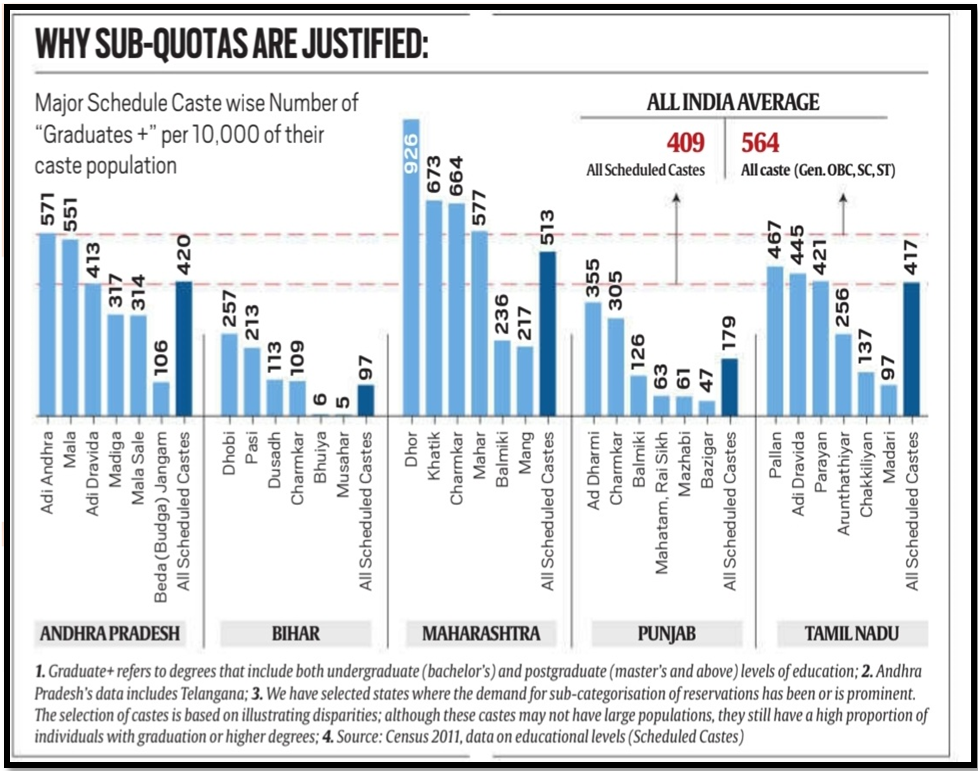SUB-QUOTA RED HERRINGS
Syllabus:
GS 2:
- Indian Constitution—Historical Underpinnings, Evolution, Features, Amendments.
- Welfare Schemes for Vulnerable Sections of the population by the Centre and States.
Why in the News?
The Supreme Court’s recent judgment on the sub-classification of Scheduled Castes (SCs) and Scheduled Tribes (STs) has sparked widespread debate. The ruling allows for differentiation within these categories to address varying levels of disadvantage, raising important legal, social, and political considerations.
Source: IE
Introduction and Context:
- Misconceptions About Verdict: The debate on the sub-quota judgment by the Supreme Court has been clouded by misunderstandings. Many assume it dilutes the reservation system, but the verdict actually aligns with progressive jurisprudence on social justice.
- Support for Social Justice: The judgment, authored by CJI DY Chandrachud, supports affirmative action and focuses on the most disadvantaged communities within the SC/ST categories, reinforcing the principle of “substantive equality.”
- Judicial Role Clarified: Contrary to claims, the court has not overstepped its bounds. It has only clarified that sub-classification is permissible under Article 341, leaving the implementation to the legislature and government.
- Empirical Evidence Exists: Criticisms that the judgment lacks empirical evidence are unfounded. The Census of India provides detailed data on the educational and economic status of SC/ST communities, highlighting the need for differentiated approaches.
- Avoiding Political Misuse: There is a concern that sub-classification could be used for political gain. However, the judgment includes safeguards requiring evidence-driven classification to prevent misuse.
Legal and Constitutional Clarifications
- Parliament’s Role: The judgment does not mandate sub-classification but allows it, leaving the decision to Parliament and state legislatures. This maintains the balance of power and adheres to constitutional principles.
- Evidence-Based Classification: The judgment emphasizes the need for a classification based on solid evidence. The Census and economic data are crucial, but a nationwide caste census for organized sector jobs and higher education institutions is necessary.
- Preventing Job Displacement: There is a risk that sub-classification could be used to reduce the number of eligible candidates for higher jobs. A rule should be implemented to ensure unfilled posts within a sub-category remain within the SC/ST category.
- Creamy Layer Concerns: The sudden introduction of the “creamy layer” doctrine for SC/STs raises several issues. The court did not fully address this, leaving room for further judicial review or legislative clarification.
- Impact on Scheduled Tribes: The judgment’s implications for Scheduled Tribes are complex, as the internal differences within STs differ from SCs. A more nuanced approach may be needed for STs, and the court should revisit this in future cases.
Chronology of Legal Tussle over Subcategorization (Punjab Case)
|
Political and Social Ramifications
- Fragmentation Concerns: Critics argue that sub-classification could create divisions within the Dalit community. However, social and political fragmentation already exists, and addressing the needs of the most disadvantaged can foster broader unity.
- Political Expediency Risks: There is a concern that sub-classification might be used as a tool for political expediency. Parties have been accused of misusing OBC sub-classification in some states, highlighting the need for careful implementation.
- Guarding Against Misuse: The judgment includes safeguards to prevent the misuse of sub-classification, but additional measures, such as a caste census, may be necessary to ensure fairness.
- Need for Legal Clarity: The judgment leaves some issues, like the “creamy layer” doctrine, unresolved. Parliament may need to intervene to clarify these aspects and prevent challenges to future sub-quota policies.
- Long-Term Social Justice Goals: Instead of focusing on sub-quota criticisms, the social justice agenda should address broader issues, such as updating SC/ST reservations according to current population data and removing the 50% ceiling on reservations.
Implementation Challenges
- Safeguards Required: The judgment allows for sub-classification, but it also emphasizes the need for safeguards to prevent its misuse. Clear guidelines and evidence-based approaches are essential for fair implementation.
- Census Data Utilization: Existing Census and economic data provide a foundation for sub-classification, but a more detailed caste census may be needed to ensure accurate and equitable classification.
- Job Reservation Rules: To prevent the reduction of eligible candidates for higher jobs, unfilled posts within SC/ST sub-categories should be transferred within the same category rather than to unreserved categories.
- Addressing Creamy Layer Issues: The “creamy layer” doctrine’s sudden application to SC/STs needs further examination. The judgment does not provide a clear operational direction, and legislative intervention may be required.
- Considerations for Scheduled Tribes: The judgment’s application to Scheduled Tribes requires careful consideration due to the unique nature of internal differences and the logic of reservations for STs.
Path Forward for Social Justice
- Correcting Judgment Flaws: The social justice movement should focus on correcting any flaws in the judgment, such as the application of the “creamy layer” doctrine, and advocate for necessary legislative clarifications.
- Expanding Reservation Criteria: Enhancing SC/ST reservations based on current population data and considering the removal of the 50% ceiling are essential steps for broadening the social justice framework.
- Long-Term Focus: The emphasis should shift from immediate criticisms of sub-quota to addressing long-term issues, such as deepening the social justice apparatus beyond public sector jobs.
- Parliamentary Action: If judicial review does not clarify certain aspects of the judgment, Parliament should step in to ensure that social justice policies remain robust and equitable.
- Unity Through Inclusivity: Creating broad, consociation arrangements within the SC/ST communities can foster unity and ensure that the voices of the most disadvantaged are heard and addressed effectively.
Conclusion
The Supreme Court’s verdict on sub-classification presents both challenges and opportunities for India’s social justice framework. While it aims to ensure more targeted benefits for the most disadvantaged, it also necessitates careful implementation and safeguards to prevent misuse and fragmentation within SC/ST communities.
Mains Practice Question
Examine the implications of the Supreme Court’s verdict on the sub-classification of Scheduled Castes and Scheduled Tribes. Discuss the potential benefits and challenges of implementing such a policy in the context of India’s social justice framework.
Source :Indian Express
Associated Article:




